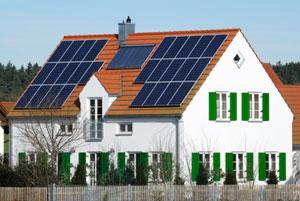
UCLA researchers are working on a new type of solar cell that could be used as a smart window and may be able to seamlessly collect energy for both small hand-held devices and large buildings. Previous attempts at creating transparent solar windows failed because of a single problem: You can have a good window, or a good solar cell, but you can't have both. In order for a photovoltaic cell to function as a window, it has to let a significant amount of light pass through. More light means less light being harvested, which sort of defeats the energy collection part of the equation. The UCLA team cleverly sidestepped the issue by harvesting more infrared light, allowing for the windows' 70 percent transparency. UCLA professor and research study leader Yang Yang is excited about the future of semi-transparent photovoltaics:
These results open the potential for visibly transparent polymer solar cells as add-on components of portable electronics, smart windows and building-integrated photovoltaics and in other applications.
At this stage, the technology is still in its infancy but it's the first step toward photovoltaics that you don’t have to see. For portable electronics, the technology could be a real game changer. At 70 percent transparency, it should be possible to mount a cell and charge your smartphone by leaving it in the sun. For homes and other buildings, you could harvest solar energy without having a huge eyesore sitting on the roof or taking up space in the yard. There's a long way to go before these windows find their way into the marketplace, but the technology is promising. It the cells are efficient and the price reasonable, they'll make a big impact.
 UCLA researchers are working on a new type of solar cell that could be used as a smart window and may be able to seamlessly collect energy for both small hand-held devices and large buildings. Previous attempts at creating transparent solar windows failed because of a single problem: You can have a good window, or a good solar cell, but you can't have both. In order for a photovoltaic cell to function as a window, it has to let a significant amount of light pass through. More light means less light being harvested, which sort of defeats the energy collection part of the equation. The UCLA team cleverly sidestepped the issue by harvesting more infrared light, allowing for the windows' 70 percent transparency. UCLA professor and research study leader Yang Yang is excited about the future of semi-transparent photovoltaics:
UCLA researchers are working on a new type of solar cell that could be used as a smart window and may be able to seamlessly collect energy for both small hand-held devices and large buildings. Previous attempts at creating transparent solar windows failed because of a single problem: You can have a good window, or a good solar cell, but you can't have both. In order for a photovoltaic cell to function as a window, it has to let a significant amount of light pass through. More light means less light being harvested, which sort of defeats the energy collection part of the equation. The UCLA team cleverly sidestepped the issue by harvesting more infrared light, allowing for the windows' 70 percent transparency. UCLA professor and research study leader Yang Yang is excited about the future of semi-transparent photovoltaics:


